Greenbridge and its Critics
You have to hand it to Bush & Company, they were spot on when they proclaimed that the free market would most assuredly take care of such problems as affordable housing. Who could have known, a mere three years ago, with housing prices skyrocketing and rents pricing out most renters, that a social revolution was brewing. Social reformers and liberals cried out for government aid to build low income housing. Who knew that the mind behind Bush had a smashing plan for bringing down the cost of housing across the board and across the nation? Genius, pure genius! Drive the economy into the ditch and pretty soon you are picking up quarter-million dollar homes for $100K in Florida and California. Here in Seattle, rents have dropped dramatically and landlords are offering incentives to get their units occupied. Problem is no one has the money to snatch the cheap real estate. Ah, the magic of the free market at work.
What, you may well ask, does this have to do with the Greenbridge development? Greenbridge is more than a housing project, it is a master plan for the community. Greenbridge, and High Point, were developed with certain assumptions in mind.
The project, launched in 2001 with a grant from the federal Hope VI program — the same program that has contributed to the redevelopment of High Point and Holly Park — is supposed to include 1,025 living units. That’s a lot more housing than Park Lake held, but a lot less of it will be subsidized for the poor. The mix is supposed to include 300 rent-subsidized units, 353 workforce rental units, and 372 homes for sale at market rates. This represents a net loss of 269 rent-subsidized units. Instead of maintaining a large pocket of low-income housing in White Center, the county decided to disperse.
As well, the project was developed before the economy hit the squids and before the current real estate meltdown. Hence, the criticism that some of the economic assumptions underlying the project were wrong.
The King County Housing Authority built the first part of Greenbridge at the height of the real estate boom, when prices for everything were sky-high. The sale of lots for market-rate housing was supposed to reimburse the county some of the cost. By the time the housing authority offered its first relatively small group of market-rate lots for sale, the market had plunged. Only one developer bid on the land, at a price way lower than expected. Having bought high, the county felt it couldn’t afford to sell low. It retracted its request for proposals. For now, the single-family portion of Greenbridge is on hold until the market picks up.
As well, some readers of this blog have expressed concern that the early learning center is a lot of wasted money, destined more for monuments than for education. Needless to say, Greenbridge and its constituent parts have no shortage of critics. This is so, despite the very involved political process used to formulate its goals. Unlike private developments, the development Greenbridge required input from a great many constituent groups. As well, the philosophy behind Greenbridge incorporates the revolution in urban planning that did away with such government-manufactured ghettos such as Chicago’s infamous Cabrini Green towers. When all is said and done, Greenbridge is supposed to be a place that is safe, pleasant and attractive. And it will be organically connected to the larger White Center Community.
More to come, but feel free to jump in with your observations and comments. (As always, be civil, or your comment will be deleted.) In the interim, here are some pictures taken on November 23rd, showing the current progress.
Tags: Greenbridge Housing Development, housing
You can follow any responses to this entry through the RSS 2.0 feed. Both comments and pings are currently closed.


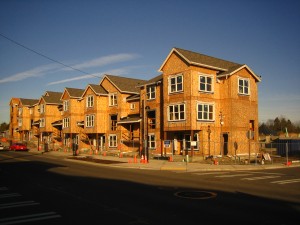

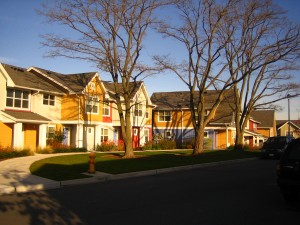

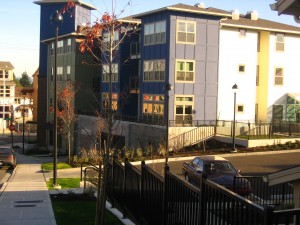
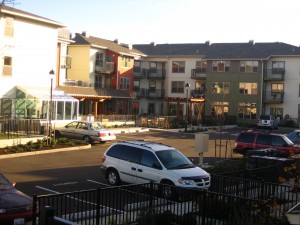
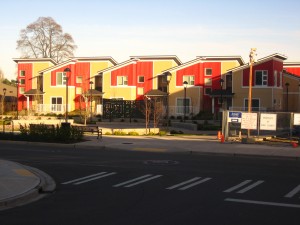
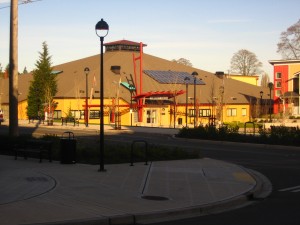
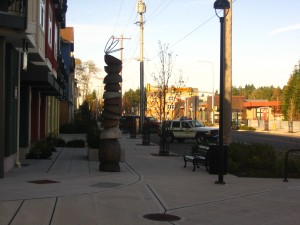
November 25th, 2008 at 1:08 pm
How easy it is to forget, for the average Hate Bush At All Costs Partisan, that the federal “affordable housing” mandate dates back to President Clinton, as, like anything Democrat-inspired, it had lofty goals with absolutely no knowledge of how markets work.
You are blinded by your hatred and typical visceral liberal rage, Ricardo. Start by looking up the names of the Freddie Mac and Fannie Mae boards for the last twenty years. I await your apology.
November 25th, 2008 at 7:30 pm
No apology called for. More articulate observers have given truth to the fantasy being spun by Bushie apologists, to wit:
It’s a satisfying bedtime story for the right. They can snooze and dream of revenge, when the wonders of True Conservatism will pave the streets with a mixture of gold and liberal bones. Unfortunately for them, it’s not only simplistic, not only demonstrative of deep prejudice, it’s also dead wrong.
The Community Reinvestment Act and other red lining laws weren’t passed to force banks to make loans to African-Americans and other minorities. They were there to make the rules consistent. Previous to the passage of the CRA, minorities were often required to have better credit, and make larger down payments to get loans equivalent to those awarded whites. Nothing in these laws required that banks lower their lending standards, only that they be fair, consistent, and operate in a “safe and secure” way. There was no evidence then, and no evidence now, that minorities with the same initial credit rating as whites tend to default on their loans at any greater rate.
Want proof? Mortgage failure rate in 2000: 1%. 2001: 1%. 2002, 2003, 2004, 2005, 2006? One (1) as in ONE percent. But wait! Everything that Carter, Reno, and Clinton could do was already in there. The nefarious community organizers of ACORN had already grown their little oak trees of pressure. Carter’s poor people had been sitting in their new homes so long, that many of those initial mortgages were paid off and gone.
What does legislation passed 31 years ago have to do with problems today? Nothing. Neither do tweaks Clinton made to that legislation in the mid 90s. The real culprits require a much shorter trip down memory lane.
Subprime mortgages (and all mortgages, really) are a fraction of the current problem. The bailout would have been enough to buy out every subprime mortgage in foreclosure across the country. In fact, it was enough to do that several times over. So why not do that?
The reason is that the purpose of the bailout (at least as Treasury Secretary Paulson sees it) isn’t to stop mortgage foreclosures, but to save the banks. And the banks have some self-inflicted problems that make those mortgages an afterthought.
For example, the wonderful credit default swap. In essence, credit default swaps are (or were) nothing but insurance policies for loans. And yet in 2007 the total number of credit default swaps traded far exceeded the value of all loans. In fact, it may have touched $70 trillion dollars, which puts it above the gross domestic product of the entire planet.
See: http://www.google.com/search?q=+cause+of+housing+crisis+daily+kos&ie=utf-8&oe=utf-8&aq=t&rls=org.mozilla:en-US:official&client=firefox-a
Credit default swaps, a result of the Gramm-Bush-Cheney deregulation regime are at the very heart of the economic meltdown. If all the Repubs have to offer is warmed over hatred against minorities and the poor, then their future is bleak indeed. As I said, no apologies needed on this end, but you are welcome to volunteer at the Food Bank and see the results of Bush’s folly.
December 1st, 2008 at 5:12 pm
Ricardo, I check out the White Center blog once in a while. Please keep your political comments off the main page. There are plenty of places I can get politicized commentary. Please focus on news and items of interest to those of us who live in the area.
December 1st, 2008 at 5:19 pm
Scott,
Almost anything of substance is going to have political implications, from the mundane (street clean-up) to the hot-button (incorporation of White Center). I don’t see how you can divorce one from the other. If you disagree, you are welcome to post your own point of view.
December 2nd, 2008 at 8:04 am
RE: Comment below Ricardo:
Want proof? Mortgage failure rate in 2000: 1%. 2001: 1%. 2002, 2003, 2004, 2005, 2006? One (1) as in ONE percent. But wait! Everything that Carter, Reno, and Clinton could do was already in there.The nefarious community organizers of ACORN had already grown their little oak trees of pressure. Carter’s poor people had been sitting in their new homes so long, that many of those initial mortgages were paid off and gone.
……………………………………………………
Ricardo stating political opinions are one thing but labeling and stereotyping people about issues and an organization you clearly do not understand or know nothing about other than what you read isn’t very nice… maybe you should delete your own biased uneducated comment based on your comment below… labeling & stereotyping isn’t civil
……………………………………………………
(As always, be civil, or your comment will be deleted.)
December 2nd, 2008 at 8:43 am
Heidi,
Not sure how the piece you quote relates to your point. As for my political opinions, they relate directly to a current fantasy being spun by the Republican Right which is that the mortgage meltdown was the result of efforts by fair housing advocates to expand home ownership to disenfranchised communities such as African-Americans and Latinos. This neat trick does two things, first, it posits that the Bush deregulation of the financial industry is not to blame for the current mortgage crisis and second, it blames the victim. Not sure what qualifies as a “biased uneducated” comment in your book but if you follow the hyperlink to the article that I quote you will see that it cites very authoritative sources and compelling data. I’m frankly confused by the tone of your comment. Do you disagree that credit default swaps, a result of the current administration’s deregulation of the financial industry, are the primary culprit in the financial crisis that has nearly bankrupted this country? And if that is indeed the case, as most economists argue, then shouldn’t we be a tad outraged? Just a thought.
December 2nd, 2008 at 9:19 am
Ricardo,
There is no tone, just a point and it is clear. The statements below are labeling and stereotyping the organization ACORN:
“The nefarious community organizers of ACORN had already grown their little oak trees of pressure. Carter’s poor people….
I can’t bold the words but nefarious & Carter’s poor people clearly are labeling words.
For you to quote ACORN and it’s members as such by labeling them…I would say in my opinion that they are uneducated comments.
December 2nd, 2008 at 9:23 am
Heidi,
The quote about ACORN is mocking the right-wing jabs at ACORN and fair housing advocates. It’s making the point that ACORN and fair housing advocates are NOT to blame for the current mess. Sorry, if that was not clear.
December 2nd, 2008 at 9:38 am
Ricardo,
Thank you for explaining that…some people like me could take it as your quote :)
For years government officials have been warned about the unfair lending practices with sub prime loans and the affect that it was going to create in our economy. They failed to listen and here we are…in a recession that could have been avoided.
Sitting in ACORN National Board meetings over the past years, this topic has sometimes dominated our conversations and there was good reason for it…we saw it coming & it’s too bad they wouldn’t listen.